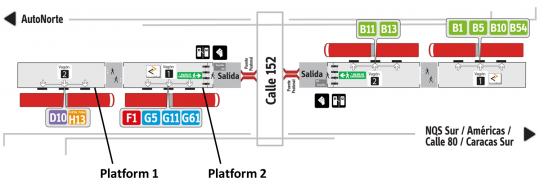Also available in:
Español
Follow the authors on Twitter: @jpvelez78, @canonleonardo and @ScorciaH
A few weeks ago, a video entitled “Why doesn’t TransMilenio work?” created a huge buzz among the residents of Bogota. The graphically impeccable video, produced by local Colombian firm Magic Markers, proposes solutions for addressing the systematic overcrowding problem faced by the city’s Bus Rapid Transit (BRT) system known as ‘TransMilenio’. It is based on research conducted in 2012 by a university professor, Guillermo Ramirez, and his students. The video has been watched on YouTube over 700,000 times and has been discussed by important national media outlets.
As urban transport experts and Bogotanos interested to see TransMilenio improved, we wrote a blog post in Spanish breaking down the video between the points with which we agree and the points with which we disagree, and circulated it in social media to further promote the debate. We are now sharing that blog post in English as we believe it offers some interesting discussion points about the challenges of high capacity BRT operations that are relevant in a broader context.
We agree
There is indeed considerable room for improvement at TransMilenio, particularly rethinking service design, reducing congestion, shortening waiting times and improving just-in-time reactions to demand surges. Guillermo Ramirez and his students make a correct diagnosis of the system’s main operational issues, and their proposals for simplifying the system’s route network certainly deserve consideration.
We believe that a process to improve TransMilenio services could benefit from a broader crowd-sourced collaboration, where the system’s management company and operators, civil society and academia collaborate in moving the debate from criticism to constructive experimentation of ideas. On our part, we will contribute additional blog entries to discuss some of our ideas on how to improve the system, and how to increase citizens’ participation. Have you ever used Transmilenio or another major BRT system? We would love to start our own crowd-sourced collaboration, so please share your insights with us in the comments section.
Follow the authors on Twitter: @jpvelez78, @canonleonardo and @ScorciaH
Why TransMilenio isn't working (Spanish)
A few weeks ago, a video entitled “Why doesn’t TransMilenio work?” created a huge buzz among the residents of Bogota. The graphically impeccable video, produced by local Colombian firm Magic Markers, proposes solutions for addressing the systematic overcrowding problem faced by the city’s Bus Rapid Transit (BRT) system known as ‘TransMilenio’. It is based on research conducted in 2012 by a university professor, Guillermo Ramirez, and his students. The video has been watched on YouTube over 700,000 times and has been discussed by important national media outlets.
As urban transport experts and Bogotanos interested to see TransMilenio improved, we wrote a blog post in Spanish breaking down the video between the points with which we agree and the points with which we disagree, and circulated it in social media to further promote the debate. We are now sharing that blog post in English as we believe it offers some interesting discussion points about the challenges of high capacity BRT operations that are relevant in a broader context.
We agree
- Traveling around Bogota is increasingly difficult, and notwithstanding the potential development of one or several metro lines in years to come, the majority of people will continue to rely on buses. However, the original master plan calling for the creation of 380 kilometers of dedicated BRT corridors by 2016 has not been fully implemented: to date, the system operates only 112 kilometers of trunk lines. Those delays have limited the system’s capacity to respond to its impressive demand growth. In that context, improving TransMilenio as well as the city’s Integrated Public Transport System (SITP) will be instrumental in addressing Bogota’s urban mobility challenges.
- TransMilenio’s route network is unnecessarily complex. The large number of routes (regular and express services) along a single corridor makes its use challenging for commuters and limits the benefits that they can derive from it. There is a need to revamp and streamline the route network to make it simpler and more efficient, and citizens’ participation in this optimization process will be fundamental. The current network was designed to minimize onboard travel time for all users, given costs and infrastructure capacity restrictions. Nevertheless, academic research has shown that express route users do not always choose the most straightforward route to reach their destination because they are confused by the complexity of the network.
- The fact that users standing at any given station observe empty buses driving by without stopping does not mean that those empty buses (or routes) are useless or poorly designed, or that they will continue running empty across the entire corridor. A bus route is designed so that the bus is completely full at the maximum load point, and not completely full during the whole extension of the route. The latter is impossible.
- The proposal formulated in the video whereby 70% of TransMilenio’s routes become regular services (i.e. stopping at all stations) and only two express routes are maintained along each trunk corridor cannot be implemented, given the current capacity of the system’s infrastructure -- mainly, its stations. The capacity of the overall system (understood as the maximum number of passengers that can travel per direction per hour) depends on the stations’ capacity to hold passengers and service buses (i.e. maximum number of buses that can stop per platform per hour). In other words, the reason why the system is currently suffering from such congestion is not the total number of buses in operation or the capacity of the segregated lanes, but rather the stations’ capacity. For instance, today’s highest capacity stations have two double platforms (able to receive two buses at the same time) and one single platform (one single bus, see image below). As such, the highest capacity stations can accommodate up to 220 buses per hour, and those with fewer platforms can receive 160 buses per hour or less. At peak hours, approximately 350 buses pass by a station in an hour during the maximum load segment (not all of them stopping). With the current route network mix of 50% regular all-stops routes and 50% express routes, 175 buses stop at highest capacity stations in hour and the other 175 go by. If the mix comprehended 70% all-stops routes instead of 30%, as prof. Ramirez suggests, those stations would receive 220 buses in an hour, which exceeds the capacity of the largest stations in the system by more than 25%.

Layout of a TransMilemio station with 2 double platforms - The 70-30 regular/express blend generates another issue: regular services take longer to complete a roundtrip journey across the corridor given the higher number of stops they serve (on average, each stop adds 30 to 45 seconds to the total travel time). Therefore, increasing the proportion of regular services would increase journey times for many users, and would ultimately reduce the system’s overall commercial speed. Also, since buses would take longer to travel their full routes, the proposal may lead to a fleet deficit that will make it impossible to sustain the high frequencies currently offered by Transmilenio.
- The video suggests that TransMilenio should operate like a simple linear system, or a “bicycle chain”, with the internal lane carrying most of the traffic and the external lane used by the few express routes traveling particularly long distances. However, we do not believe that shifting to a linear model would allow the system to maximize its capacity. On the London Underground, for instance, all trains run on the same lane at the same speed with no overtaking tracks. The Underground has a maximum capacity of 40 trains per hour-direction or 26,600 passengers per hour-direction. Meanwhile, TransMilenio’s combination of express and regular services enables it to move up to 350 buses per hour-direction, each of 160 passenger capacity, thus reaching a virtual capacity of up to 56,000 passengers per hour-direction. It is precisely this high share of express routes that allows for such an impressive capacity, higher than that of many metro systems around the world!
- TransMilenio’s private bus operators do not have any say in route scheduling or design, response to unexpected demand peaks, or the management of any other conflict. Instead, those responsibilities fall under the purview of the technical team at TRANSMILENIO S.A., the public company in charge of planning, programming and monitoring operations across the entire system. The company produces daily service scheduling and adjusts supply in real time according to live feeds from its main Control Center. This allows for very quick reactions to unforeseen events or surges in passenger demand, and guarantees the optimal operation of the system as a whole.
- The creation of a differential fare scheme by which commuters would have to pay the full fare for express services and half the fare to use regular services would not necessarily translate into an improvement in TransMilenio services. If this proposal were implemented, farebox revenue would decrease significantly and could no longer cover the cost of operations, thus creating the need for additional public resources. In addition, and perhaps more importantly, this would be a regressive fare structure that would make express services unaffordable to most lower income citizens – when they are precisely the ones who usually travel longer distances on the system.
There is indeed considerable room for improvement at TransMilenio, particularly rethinking service design, reducing congestion, shortening waiting times and improving just-in-time reactions to demand surges. Guillermo Ramirez and his students make a correct diagnosis of the system’s main operational issues, and their proposals for simplifying the system’s route network certainly deserve consideration.
We believe that a process to improve TransMilenio services could benefit from a broader crowd-sourced collaboration, where the system’s management company and operators, civil society and academia collaborate in moving the debate from criticism to constructive experimentation of ideas. On our part, we will contribute additional blog entries to discuss some of our ideas on how to improve the system, and how to increase citizens’ participation. Have you ever used Transmilenio or another major BRT system? We would love to start our own crowd-sourced collaboration, so please share your insights with us in the comments section.



Join the Conversation